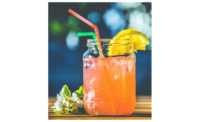Fruit Particulates' Benefits -- May 2010
Nutrition and government agencies around the world are hard at work trying to get people to eat fruits and veggies. In the U.S., the CDC has partnered with several other organizations to bring a new public health initiative, “Fruits & Veggies--More Matters™.” The World Health Organization (WHO) estimates 2.7 million lives could potentially be saved each year, if fruit and vegetable consumption was sufficiently increased. One aspect of American fruit consumption is that it is almost exclusively consumed at home. In 1998, at-home fruit consumption was estimated at about 90% and predicted to increase only to 92% by 2020, according to a USDA study. As various health messages to increase fruit consumption continue to take hold, the opportunity to provide prepared food formulations that offer the health benefits of fruit also increases.
This opportunity has not gone unnoticed by Tree Top Inc. Tree Top is an agricultural cooperative owned by over 1,300 apple and pear growers in the northwestern U.S., and is now the world’s largest producer of dried apple products. Fruits are natural, wholesome and trusted food ingredients, with several documented health benefits--all good reasons to include fruits in formulations. They also give a formulation a fresh, youthful and “innocent” aspect and are good for a wide range of foods--from the familiar to the exotic. Used correctly, they may also add a layer of texture, color and flavor to a formulation.
One route to including fruits in formulations is the use of fruit particulates. Fruit particulates come in many different varieties, levels of moisture, texture, size and shape and can match any labeling platform. Less expensive fruits, such as dates, prunes, apples and raisins, also may be included in fruit particulate mixtures to keep the cost lower. Today, apple is the blockbuster fruit used in formulation, followed by lemon, cranberry, strawberry and blueberry. Additionally, new fruits have made it to the top 20, such as açai and goji berry. Compared with the past five years, the top five fruits were strawberry, lemon, orange, apple and raspberry, and their use was more evenly distributed.
Comparing equivalents in apple fruit particulates shows many different optional characteristics to consider for formulation. For example, IQF Apple Particulates, in the measure of 110g, yields approximately 151 pieces at $0.10, 85% water and 0.98Aw; whereas, Evaporated Apple Particulates, in the measure of 17.5g, yields 129 pieces at $0.10, 24% water and 0.65 Aw or lower. Moreover, Infused Apple Particulates, at 14.2g, yields 104 pieces at $0.11, 12% water and 0.50 Aw; and Low Moisture Apple Particulates, at 13.7g, yields 171 pieces at $0.09, 2% water and 0.20 Aw. According to Jeannie Swedberg, director of business for Tree Top, “Tree Top is the leader in innovations in formulating with fruits and fruit particulates, offering the latest innovations, such as packaging fresh fruit particulates; offering unique fruit varieties and exotics; alternative drying/process technology, such as radiant zone drying; as well as label-friendly preservatives, such as calcium ascorbate.” pf
For more information:
Tree Top Inc. • Selah, Wash.
Jeannie Swedberg • 509-698-1435
jswedberg@treetop.com • www.treetopingredients.com
Looking for a reprint of this article?
From high-res PDFs to custom plaques, order your copy today!




